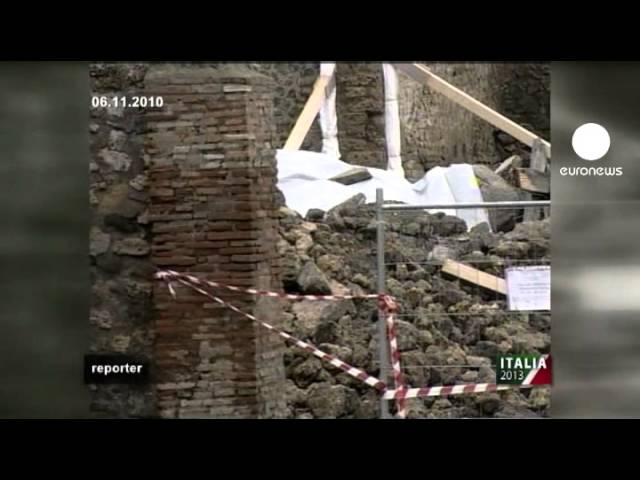Euronews Reporter – Who Pays The Bill For Italy’s Cultural Heritage
Ask any tourist, from New York to Beijing, to name an Italian monument. The answer will probably be the Colosseum. With nearly 2,000 years of history, the amphitheatre built under the leadership of the Roman emperors of the Flavian dynasty, for circus games and gladiatorial combats, is the most visited monument in the country. Almost 5 million take in its wonder every year. Its popularity provides a benefit which is more down to earth for the Colosseum generates some five billion euros each year.
But the Colosseum is also a symbol of how this unique resource is managed. The budget for study preservation and management of the amphitheatre is just 800,000 euros a year. That money pays for the cleaning of the marble for instance and the study and cataloguing of the archaeological pieces found on the site. Italy has no natural oil wealth but an historical and cultural resource fashioned through 28 centuries of an unbroken civilisation. It is a simple truth but difficult to translate into practice.
“I’ll tell you a popular joke. It is funny but also bitter and goes like this: “You know that 60% of the world’s cultural heritage is in Italy? And the rest? The rest is safe!” That’s the problem with Italy’s cultural heritage. There was a culture of government in this country that considers the heritage simply as an added expense an unnecessary expense an economic burden, ” said Vittorio Cogliati Dezza head of the environmental organisation Legambiente
Italy has the most number of classified Unesco heritage sites. Forty-seven in all ahead of Spain and China with 44 and 43.
And yet mere crumbs are allocated to manage this wealth. In the last 10 years, the budget has been virtually cut in half. From a little over €2 billion it has fallen to less than one and a half billion in 2011.
Maybe it is not surprising then to hear more and more alarming information on the state of the conservation of this heritage. In recent weeks, for example, a, “red zone” of 15 meters has been imposed around the Colosseum to protect passers-by from any material which crashes down from the façade. According to archaeologists in the last two years as many pieces have fallen from site as in the last 10 years.
Then the idea was put forward to use philanthropists, entrepreneurs who would be willing to sponsor the restoration of a monument. Diego della Valle the CEO of the Italian leather goods company Tod’s put 25 million euros up for the Colosseum. That sponsorship model has been copied and on January 28, the fashion house Fendi announced a deal of more than two million for the Trevi Fountain.
The work scheduled to be paid for by the sponsorship is on hold at the Colosseum after a dispute over the awarding of the tender only the most urgent paid for by the government is continuing. There are also question marks over the whole idea of a company receiving publicity for its sponsorship on a heritage which belongs to the country. The director sees no conflict of interest.
“The Colosseum needed sponsorship 20 years ago. It is clear that the Department did not have the funds to deal with a complete restoration of the amphitheatre. Twenty years on the situation has worsened, so welcome to backing from a private company. The sponsorship agreement provides no possibility of advertising on the monument, ” explained Archaeological director of the Colosseum Rossella Rea.
“This is not a sponsorship, it’s a fire sale! For a few cents we sell off a private monument that represents Italy and can be used for advertising and commercial operations. They say it is not like that, but we have read the contract. They will cede the naming rights to third parties and other private concerns to be able to say “Friends of the Colosseum,” opined Carlo Rienzi Head of consumer association Codacons.
Pending court decisions, there is another serious and urgent problem, traffic. Despite a partial pedestrianisation zone, more than 2,000 vehicles per hour pass here. There are now at least 3000 cracks in the Colosseum and there is the construction of a new metro line close by.
In Pompeii, near Naples, lie the remains of the city where the wealthy citizens of ancient Rome enjoyed holidays. In seventy-nine AD the volcanic eruption of Vesuvius froze in time twelve-thousand inhabitants. Frozen? That is easier said than done, because the second most visited site in Italy, on the Unesco list since 1997, has deteriorated inexorably.
Find us on:
Youtube
Facebook
Twitter

I’ll pay for it send me the bill
UNESCO have pay the bills, When UNESCO declare an historycal site “heritage of humanity”, the site isn’t longer only of italian people, but of entirely world population.